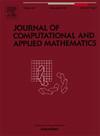为模拟所有马赫数流动建立一个精确和可靠的数值方案
IF 2.6
2区 数学
Q1 MATHEMATICS, APPLIED
Journal of Computational and Applied Mathematics
Pub Date : 2025-10-03
DOI:10.1016/j.cam.2025.117133
引用次数: 0
摘要
HLLEM格式是计算欧拉方程和Navier-Stokes方程对流通量的一种常用数值方法,具有精度高、保正性好等优点。然而,它仍然有两个缺陷。一是涉及多维强激波的计算中的数值不稳定性,如红玉现象;二是低马赫数流计算精度问题导致的非物理结果。在工程领域中,强激波的高马赫数流动和低马赫数流动往往并存。因此,有必要开发一种在所有马赫数流动中既准确又鲁棒的数值格式。通过简单地改变波速来平衡平流耗散和声耗散,解决了HLLEM方案的激波不稳定性问题。此外,通过控制动量方程中速度差项对应的过多数值耗散,提高了低速流的计算性能。高马赫数和低马赫数测试用例的数值结果证明了所提出的方案对模拟所有马赫数的流动的准确性和鲁棒性。本文章由计算机程序翻译,如有差异,请以英文原文为准。
Development of an accurate and robust numerical scheme for simulating all Mach number flows
The HLLEM scheme is a popular numerical method for computing the convective fluxes in the Euler equations and the Navier–Stokes equations due to its accuracy and positivity-preserving. However, it still has two defects. One is the numerical instability, such as the carbuncle phenomenon, in computations involving multidimensional strong shock waves; the other is the non-physical results caused by accuracy issues in computations of low Mach number flows. In the engineering field, high Mach number flows with strong shock waves and low Mach number flows often coexist. Therefore, it is necessary to develop a numerical scheme that is both accurate and robust across all Mach number flows. The shock instabilities of the HLLEM scheme are addressed by simply modifying the wave speeds to balance advection dissipation and acoustic dissipation. Additionally, the performance in computing low-speed flows is improved by controlling the excessive numerical dissipation corresponding to the velocity-difference terms in the momentum equations. Numerical results from high Mach number test cases and low Mach number test cases demonstrate the accuracy and robustness of the proposed scheme for simulating flows across all Mach number.
求助全文
通过发布文献求助,成功后即可免费获取论文全文。
去求助
来源期刊
CiteScore
5.40
自引率
4.20%
发文量
437
审稿时长
3.0 months
期刊介绍:
The Journal of Computational and Applied Mathematics publishes original papers of high scientific value in all areas of computational and applied mathematics. The main interest of the Journal is in papers that describe and analyze new computational techniques for solving scientific or engineering problems. Also the improved analysis, including the effectiveness and applicability, of existing methods and algorithms is of importance. The computational efficiency (e.g. the convergence, stability, accuracy, ...) should be proved and illustrated by nontrivial numerical examples. Papers describing only variants of existing methods, without adding significant new computational properties are not of interest.
The audience consists of: applied mathematicians, numerical analysts, computational scientists and engineers.

 求助内容:
求助内容: 应助结果提醒方式:
应助结果提醒方式:


